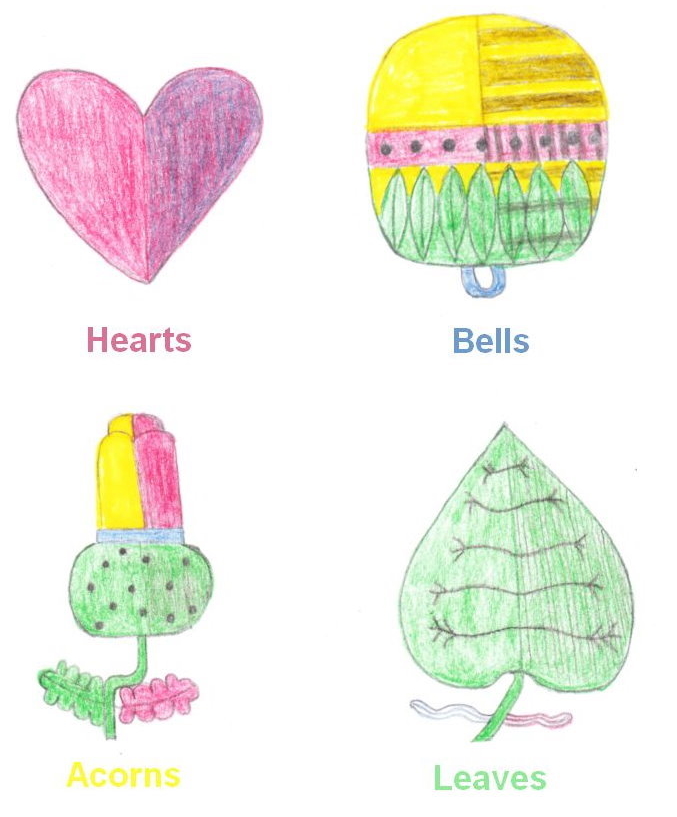 Each of the four types of sub-games featured in the game is designed to be a different variant of the game Sixty-Six as played in various areas of the World. Dreek
itself is highly popular in the Franconian area of Germany and as such is usually played there using the 24 card German or Franconian suited deck of cards. The cards in this deck are of the denominations 9, 10, Unter, Ober, King, Ace, with one card of each of these denominations in each of the German suits (Hearts, Bells, Acorns, and Leaves) that comprise this deck. The Unter is sometimes called the Under Knave and the Ober is called the Over Knave. The numerical cards 9 are 10 are sometimes printed using the Roman numeral representation of that number on the face instead of the corresponding Latin numerical representation. If such a traditional German or Franconian deck is not at hand, a standard French deck can also be used in which all cards lower than nine have been removed. The ranking of the cards in this deck are as follows, from highest to lowest; Ace, 10, King, Ober (or Queen), Unter (or Jack), 9.
Each of the four types of sub-games featured in the game is designed to be a different variant of the game Sixty-Six as played in various areas of the World. Dreek
itself is highly popular in the Franconian area of Germany and as such is usually played there using the 24 card German or Franconian suited deck of cards. The cards in this deck are of the denominations 9, 10, Unter, Ober, King, Ace, with one card of each of these denominations in each of the German suits (Hearts, Bells, Acorns, and Leaves) that comprise this deck. The Unter is sometimes called the Under Knave and the Ober is called the Over Knave. The numerical cards 9 are 10 are sometimes printed using the Roman numeral representation of that number on the face instead of the corresponding Latin numerical representation. If such a traditional German or Franconian deck is not at hand, a standard French deck can also be used in which all cards lower than nine have been removed. The ranking of the cards in this deck are as follows, from highest to lowest; Ace, 10, King, Ober (or Queen), Unter (or Jack), 9.
A full game of Dreeg is thus played over a series of eight sub-games. Thus, each sub-game is played to completion, and then, after all eight of the sub-games have been finished (which is thus played to determine a loser of that sub-game), it is determined who the overall winner of the entire game is based on which player has lost the fewest sub-games. Each of the eight sub-games is played in order, and is one of four types. The following lists the four types of games which will be played during a full game of Dreeg:
- Sechsundsechzig (or Deutsch): This sub-game is played very similarly to the standard game Sixty-Six (from which this sub-game gets it's name). This sub-game is played over a series of hands with players attempting to capture as many card points as possible. Each card in the deck has a specific card point value as per the following chart:
- With Four Players: The current dealer first deals each player a total of six cards face-down, in two packets of three. The last card in the deck, which belongs to the dealer, is turned face-up on the table such that all players can see the card. The suit of this card will be the designated trump suit throughout the remainder of that hand. After each other player has been able to see this card, the dealer then takes it into his hand. The player to the immediate left of the dealer then plays the first card to the first trick.
- With Three Players: The rules for this sub-game are almost identical as played by three players. The only differences being in the scoring at the end of the hand and the fact each player received eight total cards in the deal. The player scoring the most card points during the hand (including any declarations) is allowed to subtract 2 points from his ongoing sub-game score and the player winning the second most points may subtract 1. If two players tie for the same number of card points, the player amongst those players considered to have more card points, is the one who won the last trick. If neither of the tying players captured the last trick, each of the tying players scores the number of points the least high scoring player of that group would score (which might be 0).
- With Two Players: The rules for this sub-game are somewhat different if played by only two players, and are essentially exactly identical to the two-player game Sixty-Six. Thus the dealer begins by dealing each player a three-card face-down packet. He then deals one card face-up to the center of the table, and then another three card face-down packet to each player. He then places the remainder of the deck, face-down partially covering the exposed card. This exposed card is the trump indicator for the hand, and the suit of this card indicates the trump suit to be used for this hand. This card remains on the table during the whole hand and belongs to neither player. However, if a player, on his turn, has won at least one trick during the game, and has the nine of the trump suit in his hand, he may, on his next opportunity to lead to start a trick, may exchange the nine of trump suit, taking the exposed trump card into his hand as the trump nine's replacement. However, this exchange cannot occur if a player has not done so before the seventh trick is played.
- Ace of Hearts: The second sub-game that will be encountered is called "Ace of hearts". This variant is similar to the other variants, with players attempting to capture as many card points as possible. However, in this version the dealer does not expose the last card in the deck as the trump indicator. Instead he simply deals this card to himself as normal. However, whichever player finds they have the Ace of hearts in the hand must announce this fact, and is also entitled to declare the trump suit to be used for this hand (which can be any suit of his choosing). If the player dealt the Ace of trumps opts, he can choose to "surrender". He must announce this before play begins. This ends the hand immediately and entitles each opponent of the surrendering player to subtract two points from their sub-game score.
- Rufen (or Calling): The Rufen mini-game allows the player to the immediate left of the dealer (called forehand) to play with the aid of a partner. The identity of this partner will not initially be known until play of the first trick.
- If the opposing team has scored 33 or more points, each player on the winning team is entitled to subtract one game point.
- If the opposing team has less then 33 points, but has won at least one trick during the hand, each player on the winning team is entitled to subtract two game points.
- If the opposing team has not managed to win at least one trick during the hand, each member of the winning team is entitled to subtract 3 game points.
- If a team has scored at least 66 points and the opposing team has scored less than 66 points but more than 33 points, each player on the winning team is entitled to subtract one game point.
- If a team has scored at least 66 points and the opposing team has less then 33 points, but has won at least one trick during the hand, each player on the winning team is entitled to subtract two game points.
- If a team has scored at least 66 points and the opposing team has not managed to win at least one trick during the hand, each member of the winning team is entitled to subtract 3 game points.
- If both teams score 66 or more points during the hand, the team that won the last trick of the hand is said to win that hand, and each member of that team is entitled to subtract one game-point.
- If both teams score less than 66 points, the team that won the last trick during the hand is the winner of the hand and each member of that team is entitled to subtract one game-point from their sub-game score.
- Kamerun: The last of the four sub-games is called Kamerun. This game is a sort of reversal to the goal of each player in the other three sub-games, as during the Kamerun mini-game the usual object is to attempt to win the fewest number of card points during every hand. In addition, in this mini-game, the first player to subtract all of his game points during the hand is declared the loser of the mini-game.
- If the winner of the first trick had announced "Durchmarsch", and that player managed to win every trick during the hand, each opponent must subtract three game-points.
- If the winner of the first trick had announced "Durchmarsch", and that player lost one or more tricks during the hand, that player must subtract three game-points from his current sub-game game-points score.
- If no player announced "Durchmarsch", and a player wins no tricks during the hand, that player subtracts nothing from his game point score.
- If no player announced "Durchmarsch", the player who took the most card points must subtract 3 game-points, the player winning the second most subtracts 2 game points, and the player winning the third most card points must subtract 1 game point. The player winning the fewest card points during the hand is not required to subtract any game points on that hand. If there is a tie in game points amongst two or more players, the player amongst those players (if any) who won the last trick is said to have the higher score and must subtract the greater number of game-points. However, if, among tied players, none of those players won the last trick, all those tied players must subtract the largest number of game points which would be required for any of those tying players. The Kamerun sub-game is also different from the other sub-games as this sub-game game continues only until the first player erases his last game-point. Thus, there would not normally be a three player or two player version of this sub-game (if the game was started with four players). Thus the first player to bring his score to zero or less during this game is considered the loser. Since multiple players will usually need to subtract game-points during a Kamerun sub-game, it is possible more than one player could end up dropping their game-points below zero. To help prevent this the usual rule is that the players needing to subtract three total game-points do this first, and if there is no loser, those needing to subtract two game-points would do this next, and if still no loser, any players needing to subtract one game point would do this. If multiple players subtracting the same number of game points drop their score to zero or less, all those players would then be considered to have lost the sub-game.
| Card | Point Value |
|---|---|
| Ace | 11 |
| 10 | 10 |
| King | 4 |
| Queen (or Ober) | 3 |
| Jack (or Unter) | 2 |
| 9 | 0 |
The card led to a trick can be any card of choice still remaining in that players hand. After the lead card, each other player, in a clockwise direction around the table then plays one card remaining in their hand, face-up to the same trick. If the player has a card of the same suit as originally led to that trick he must player it. If the player does not have a card of the suit originally led to the trick, he must play a card in the trump suit if he has one. If he has no card of the trump suit, he may play any other card from his hand. In play, the player must attempt to win the trick if at all possible. Cards won in tricks are set aside, out of play, and the winner of the previous trick leads the first card to the next trick.
The hand continues in this way until all the tricks have been played and won. The players then examine the cards won in tricks and calculate the number of total card points won in tricks during the hand (as per the card points chart shown above). The player who managed to capture the most card points is entitled to subtract three points from his hand (see the scorekeeping section, below), the player capturing the second most card points subtracts two from his sub-game score, and the player capturing the third most card points subtracts one. The player capturing the least amount of cards points on the hand subtracts no points from his sub-game score. If two or more players tie for the same number of card points, the player amongst those players (if any of those players) who managed to capture the last trick of the hand is said to have a higher score of those players. If none of those players took the last trick, each of those tying players then earn the smallest number of points which would be won amongst those tying players.
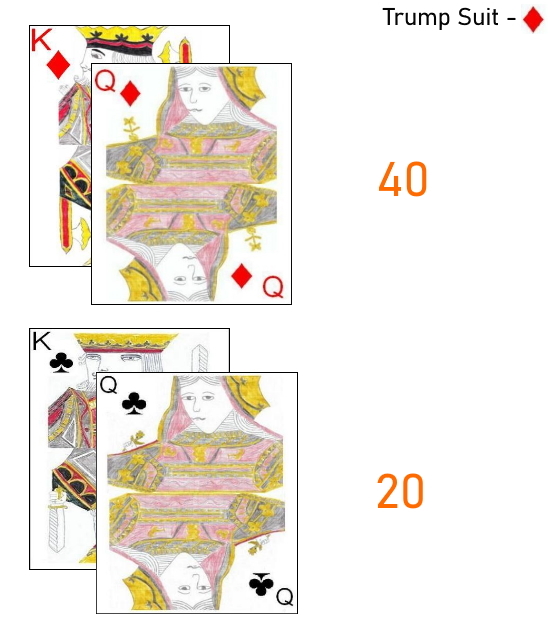 If a player finds that he has, in his hand, before his lead, a King and (Ober) Queen of the same suit, he may then show these cards before his lead, and then lead one of the cards forming the combination to the trick. This will earn that player a number of bonus they can add to their card points for that hand. If the King and Ober are of the designated trump suit, that earns the player 40 points, and if in any other suit it earns the player 20. A player may declare multiple such combinations, but he may only show one such combination upon his lead to a trick. In order to allow these points to be added with his cards points for that hand, the player must have won at least one trick during the hand.
If a player finds that he has, in his hand, before his lead, a King and (Ober) Queen of the same suit, he may then show these cards before his lead, and then lead one of the cards forming the combination to the trick. This will earn that player a number of bonus they can add to their card points for that hand. If the King and Ober are of the designated trump suit, that earns the player 40 points, and if in any other suit it earns the player 20. A player may declare multiple such combinations, but he may only show one such combination upon his lead to a trick. In order to allow these points to be added with his cards points for that hand, the player must have won at least one trick during the hand.
If any player believes, that, after winning any trick, his partnership (either the lone player who declared the trump suit for the hand, or the combined score of all opponents of that player) has captured 66 or more card points (including announcements), that player may immediately state this. This ends the hand at once, and the captured points are checked. If the player was correct, these opponents each earn the requisite number of points. If wrong, however, the members of the opposing team (either the trump declarer or the three opposing players) each are entitled to subtract two sub-game points from their current score.
Trick play during the two player hand is similar to the four and three player version of this sub-game, with two differences. One such difference being that after every trick is won, the winner of the trick takes the top card from the remaining stock pile and his opponent takes the next card. The exposed trump card indicator (or the exchanged nine of trumps) is considered the last card of the deck and is thus drawn as the last card in the stock. The other difference is that, while the draw pile still contains two or more cards, a player is not obliged to play a card of the same suit as led to the trick and may play a card of the trump suit or any other suit if they prefer. Once the stock is reduced to two cards or less, the strict requirements regarding playing to an existing trick apply as normal.
Also, in the two player variation, a player has the option to "Close" the draw pile (talon). He may do this immediately after winning any trick or before leading to a trick, as long as the talon contains at least four cards before he announces this. He designates this "Close" by taking the exposed trump indicator card and placing that card face-down on the stock pile. Once the hand has been "Closed" in this way, no more cards are drawn from the stock after each trick, but the players complete the hand using the cards remaining in their hands.
In the two player variant of this sub-game, the player who takes the most card points is entitled to subtract one point from his sub-game score and his opponent may subtract nothing.
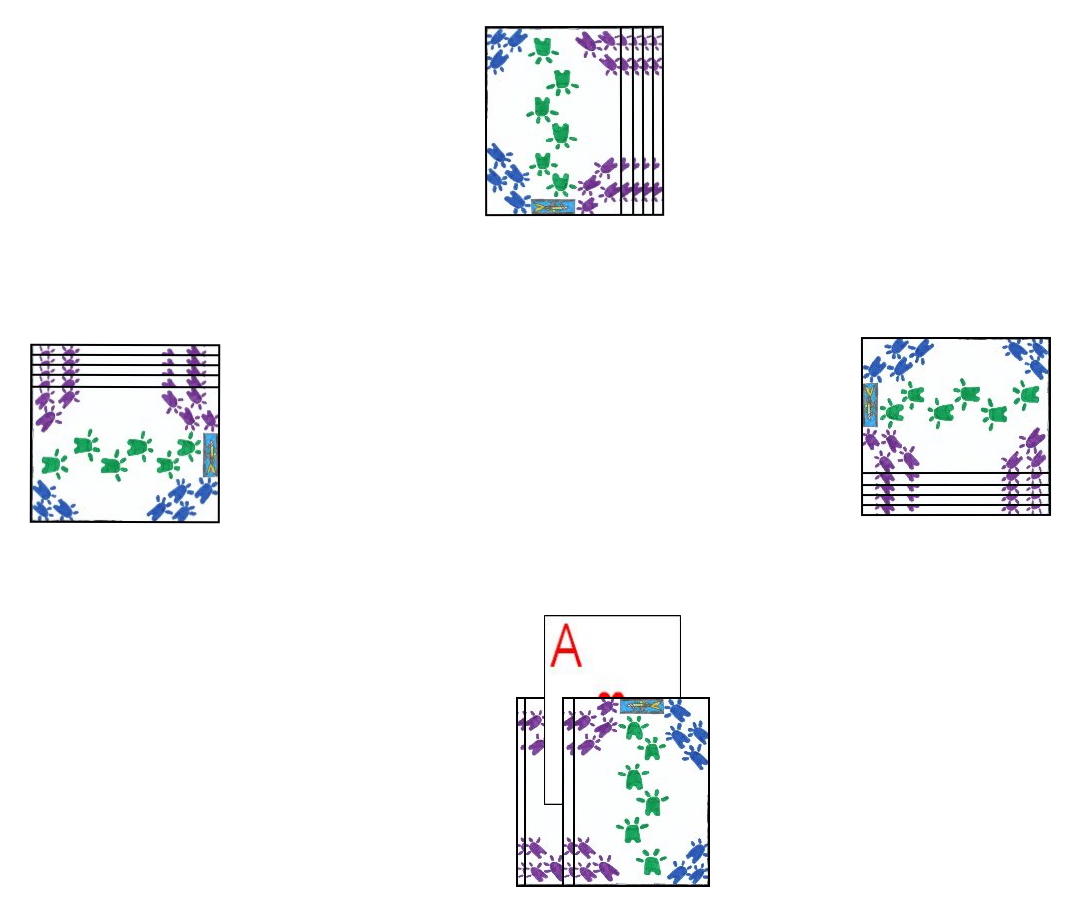
Other than the method of selection of the trump suit, the three and four player version in the Ace of Hearts hands is played identically to the Deutsch hand.
The two player version of the Ace of hearts sub-game is also similar, with players drawing cards from the stock after every trick, until the stock becomes empty. During the deal, no trump suit is exposed, with the player who has (or draws) the Ace of hearts into the hand having the privilege of declaring it. If this card is initially dealt to one of the players, that player should declare it as normal. However, it is common for that card to still be found in the draw pile and thus no player has yet received it. In that case, the game is played with no trump suit until a player draws this card, at which time the player should immediately state he has the card and select the trump suit to be used for the remainder of that hand. Obviously, until the trump suit is determined, declaring an announcement of a "King and Queen", earns that player 20 points. Players can also declare the stock closed, even if the trump suit has not yet been declared. In that case the remaining hand is played using the cards as found in the players' hand and played without a trump suit. However, at that point forward in that current hand, players must play a card of the suit led to the trick and must attempt to win the trick, if able.
During the two player version, after the third trick has been played and both players have drawn a card from the stock as normal (providing the deck has not been Closed and the Ace of Hearts has not yet been drawn by either player), the dealer then immediately turns over the entire stock pile, turning it face-up, ensuring only the top card of this pile is exposed. In drawing, the players then draw the top face-up card from this exposed stock pile, and both players will then see the exact cards being drawn by both players. Once one player has draw the Ace of Hearts from this pile, and both players have completed their draw, the pile is turned face-down again, with the player who drew the Ace of Hearts announcing the trump suit to be used for the remainder of the hand. The dealer then takes the remaining stock and turns it face-down on the pile, with the players, after each trick, then drawing their cards from the top of the face-down stock pile again.
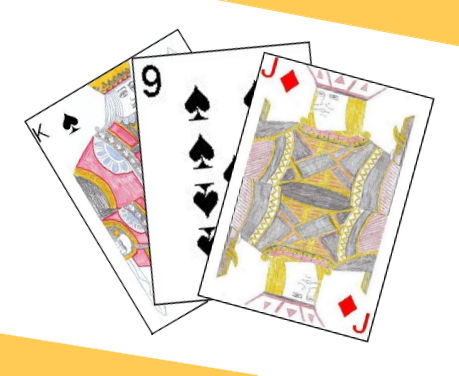 Thus, in the four player Rufen sub-game, after the first three cards have been dealt by the dealer, the player to the immediate left of the dealer picks up these cards for review. After reviewing those cards, that player then announces a specific card not found in his hand, by rank and suit. The card called must be of a suit of a card that player has in his initial hand of three cards. The suit of the called card is set as the trump suit for the hand. After the player has called the card, the other players then also pick up their first three cards and the dealer then deals an additional packet of three face-down cards to each player, which they also add to their hand. Whichever player has been dealt the specific card called by the player is the temporary partner of the player for the duration of the hand. If the player calling the card ends up having the called card in his hand (either because it was dealt to him in the second three card packet, or because he intentionally chose to call a card he already had in hand) he must then play solo against the remaining players without the aid of any partner.
Thus, in the four player Rufen sub-game, after the first three cards have been dealt by the dealer, the player to the immediate left of the dealer picks up these cards for review. After reviewing those cards, that player then announces a specific card not found in his hand, by rank and suit. The card called must be of a suit of a card that player has in his initial hand of three cards. The suit of the called card is set as the trump suit for the hand. After the player has called the card, the other players then also pick up their first three cards and the dealer then deals an additional packet of three face-down cards to each player, which they also add to their hand. Whichever player has been dealt the specific card called by the player is the temporary partner of the player for the duration of the hand. If the player calling the card ends up having the called card in his hand (either because it was dealt to him in the second three card packet, or because he intentionally chose to call a card he already had in hand) he must then play solo against the remaining players without the aid of any partner.
The forehand player leads the first card to the first trick and this card must be a card of the trump suit. Each other player in a clockwise direction around the table adds one card from the hand to the trick. The play of the cards to the trick is the same as in the Deutsch mini-game, however, which other player has the called card must play that card to this first trick. If the calling player ends having the called card in his hand he must lead this card to start the first trick.
If the calling player has a partner for the hand, both these players combine their card points captured and if a player believes his team (either the caller and his partner or the opposing team) has scored 66 or more points, that player may announce this fact which immediately ends the game. All card points are totaled for both teams are then immediately scored. If the team did, in fact manage to score at least 66 total card points (regardless of how many points the opposing team has), that team is said to win the hand and the players in that team score as follows:
A player may thus announce that he believes his team has won immediately after winning a trick or after making a declaration. This announcement may no longer be declared after the second-to-last trick has been led. If neither team thus announces this, the hand is played to completion, and the card points for both partnerships are totaled, with game-point scores awarded as follows:
In the three or four player variant, the caller will thus play solo against two other players or will have a temporary partner for the hand, playing against one or two opponents. However, the two player version of this sub-game is played a bit differently. In this case both players are dealt 6 cards and the remaining cards are placed in the middle of the table as the stock pile or talon. As there are only two players, no partners are called, with the opponent of the dealer picking up his first packet of three cards as dealt, and naming the trump suit based on these three cards. Play of the hand with two players is the same as in the two player Deutsch version save for the fact there is no exposed trump indicator card as the dealers opponent simply called the trump suit to be used for the hand.
While in the other sub-games as featured in the game of Dreeg, in which the players strive to be the first to subtract all seven of their game-points during that mini-game, in Kamerun, the goal is quite the opposite, with players attempting to avoid subtracting such points from their game-points total for that sub-game.
In a Kamerun sub-game, the dealer deals each player six total cards, with no trump suit declared or used during the hand. The rules for trick play during this is the same as in the other sub-games, with players forced to follow-suit if possible, and if unable to follow-suit, trumping if able, and always attempting to win the trick if possible. The one difference is that, the winner of a trick is not allowed to lead a card of the same suit as was led to the previous trick unless he only has cards of that suit in his hand. The player to the immediate left of the dealer leads the first card to the first trick and the winner of each trick leads the first card to the next trick.
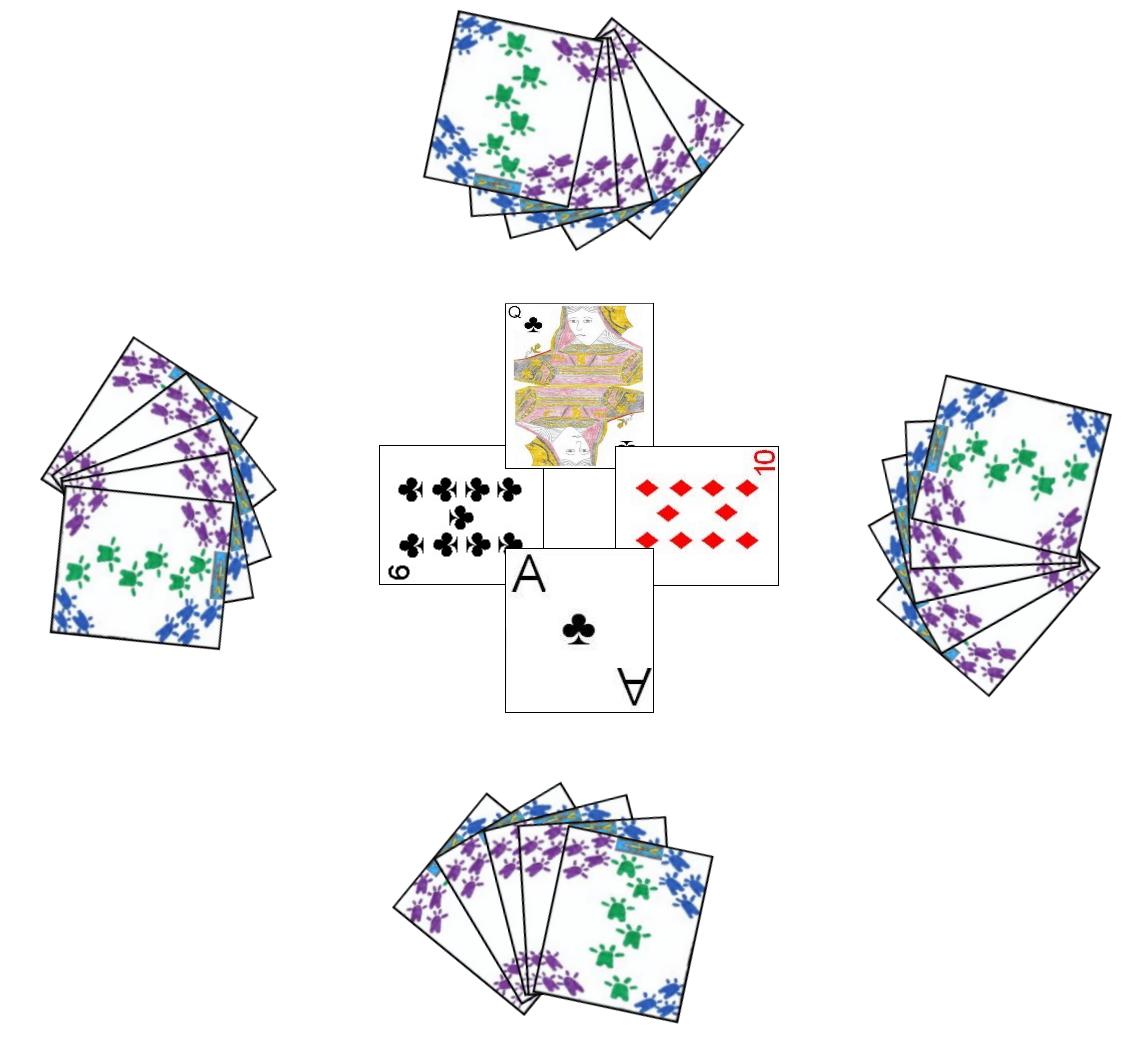 After the first trick is played and won, the winner of that trick does have
one special option. He may, if he feels he has a strong hand, announce
"Durchmarsch", which is an intention to win every trick during this hand. He
must, however, make the Durchmarsch announcement before leading his first
card to the second trick. After all the tricks have been played, the players
then total the card points they earned during the hand for potential
subtracting of game-points.
After the first trick is played and won, the winner of that trick does have
one special option. He may, if he feels he has a strong hand, announce
"Durchmarsch", which is an intention to win every trick during this hand. He
must, however, make the Durchmarsch announcement before leading his first
card to the second trick. After all the tricks have been played, the players
then total the card points they earned during the hand for potential
subtracting of game-points.
Thus, as noted, a full game of Dreeg is played as a series of eight sub-games. Each sub-game is played until completed, and then the next sub-game begins. The losing player (or players) of that sub game should be noted, and then, each player is again set to seven game points for the next sub-game. In total, 8 sub-games are played in a full game. The following is the ordering of these sub-games:
|
Trivia: Each of the four sub-game types in Dreeg is intended to represent a variation of the popular card game Sixty-Six as played in various Nations of the world, specifically Germany, Russia, England, and Cameroon, respectively. |
During play of the sub-games Sechsundsechzig, Ace of Hearts, and Rufen, the game is continued until there is only one player remaining. As players, after each hand, deplete their number of game-points for that sub-game to zero or less, they are entitled drop from the hand, and the game continues until there is only one player remaining, who is considered the loser of that sub-game, and this is marked on the score for that player for eventual scoring at the end of the entire game. In the game of Kamerun, however, the sub-game ends once one or more players has depleted their score to 0 or less, with that player set as the loser of that sub-game.
After each mini-game, the loser of that mini-game elects who will be the dealer for the first hand of the next mini-game (he may also elect himself to be this dealer). After each hand during the mini-games, the deal rotates around the table in a counter-clockwise direction. For the very first mini-game of a full game, the dealer can be determined by draw from the shuffled deck, with the player drawing the highest ranked card set as the first dealer for the first hand in the first mini-game. The number of cards dealt to each player during each round is also directly dependent on the number of participants in that hand. For four active players, each player receives six total cards, for three each player received eight total cards and with two players each player again receives six total cards. If a player who dropped from the hand was the next to deal, he should still deal that next hand, although he need not deal himself any card as he has been entitled to drop from that mini-game.
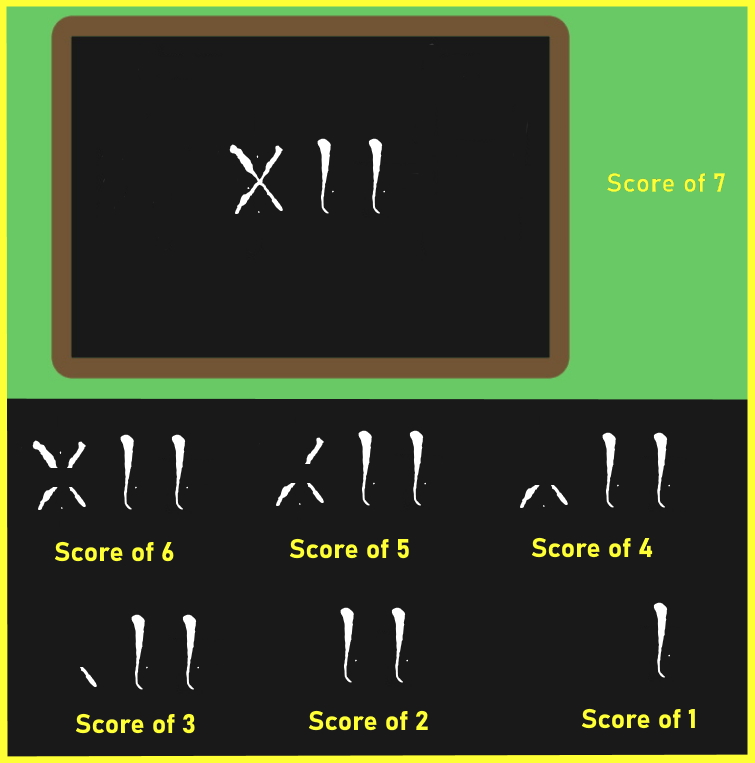 Scorekeeping: As mentioned scores are retained for each mini-game as a series of game points (also called strokes) that players may win or lose during that mini game. Traditionally scoring for this game is recorded using chalk and slate. Each player usually has a small slate and a piece of chalk. At the start of each of the eight mini-games, each player draws a large diagram on his slate resembling the Roman number 12 (XII). This diagram is intended to represent 7 game points or strokes, in which the players begin each sub-game with. The X represents five such strokes, one for each arm of the X and one for the center (which should be erased first). Each of the I characters also represents one stroke in the drawing.
Scorekeeping: As mentioned scores are retained for each mini-game as a series of game points (also called strokes) that players may win or lose during that mini game. Traditionally scoring for this game is recorded using chalk and slate. Each player usually has a small slate and a piece of chalk. At the start of each of the eight mini-games, each player draws a large diagram on his slate resembling the Roman number 12 (XII). This diagram is intended to represent 7 game points or strokes, in which the players begin each sub-game with. The X represents five such strokes, one for each arm of the X and one for the center (which should be erased first). Each of the I characters also represents one stroke in the drawing.
Thus, as the players are entitled to subtract game points from their score in that sub-game, they would erase one of the strokes in the diagram. If they are entitled to erase more strokes than they have remaining in their diagram, they simply erase all such strokes remaining. As mentioned previously, in the mini-games of Deutsch, Ace of Hearts, and Rufen, players strive to erase as many strokes as possible. Once a player erases is last stroke for that mini-game, he then drops from that mini-game, allowing the remaining players to continue play. This continues until three players have managed to drop from the hand, leaving just one player remaining who is said to be the loser of that mini-game. This is thus indicated by that player on his slate by marking a circular dot, or blob on the corner of his slate (called Bollern).
However, with the Kamerun mini-game, the goal is different and players instead strive to avoid losing game points and thus erasing strokes from their diagrams. This mini-game ends as soon as one player is forced to erase his last stroke from his diagram, ending the mini-game, with that player being set as the loser of that mini-game and thus adding the blob marker on his slate. If multiple players, on the same hand subtract their last strokes on the hand, both of those players earn a blob as the losers of that mini-game.
To start the next mini-game the players erase any remaining strokes on the slate (but retaining any blobs added to the slate during the current game) and draw a new diagram from which they will then begin progressively erasing strokes to determine the loser of that game.
Once all eight mini-games have been played and completed, in the given order, the player with the fewest blobs is declared the overall game winner.